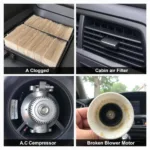Car paint self repair can be a cost-effective solution for minor scratches and chips. This guide provides a detailed look at DIY car paint repair, covering everything from assessing the damage to achieving a professional-looking finish. We’ll explore the various techniques, tools, and materials you’ll need to tackle those unsightly blemishes and restore your car’s appearance.
Assessing the Damage: Is Car Paint Self Repair Right for You?
Before diving into car paint self repair, it’s crucial to assess the extent of the damage. Minor scratches and chips that haven’t penetrated the primer coat are usually good candidates for DIY repair. However, deeper scratches, dents, or damage involving the underlying metal require professional attention. Knowing the difference will save you time and potentially prevent further damage.
For minor scratches, a simple touch-up paint application might suffice. Deeper scratches may require sanding, priming, and multiple coats of paint. Always start with a thorough cleaning of the affected area to remove dirt, wax, and debris.
Gathering Your Car Paint Self Repair Arsenal: Tools and Materials
Having the right tools and materials is essential for a successful car paint self repair project. You’ll need touch-up paint that precisely matches your car’s color, sandpaper of varying grits, masking tape, primer (if necessary), rubbing compound, polishing compound, and microfiber cloths. Investing in quality materials will ensure a seamless and long-lasting repair.
Don’t forget essential safety gear like gloves and eye protection. Proper preparation is key to a smooth and safe car paint self repair process.
Step-by-Step Guide to Do It Yourself Car Paint Repair: From Prep to Polish
- Clean the area: Thoroughly wash and dry the damaged area.
- Mask the surrounding area: Use masking tape to protect the undamaged paint.
- Sand the scratch (if necessary): Start with a coarser grit sandpaper and gradually move to finer grits.
- Apply primer (if necessary): If the scratch has penetrated the primer, apply a thin coat of primer and let it dry completely.
- Apply touch-up paint: Apply thin, even coats of touch-up paint, allowing each coat to dry before applying the next.
- Sand the repaired area: Once the paint is dry, use fine-grit sandpaper to level the repaired area with the surrounding paint.
- Apply rubbing compound: Use a rubbing compound to remove any sanding marks.
- Polish the area: Finish with a polishing compound to restore shine.
“Patience is key when performing car paint yourself over scratch repair,” advises John Smith, a veteran auto body technician. “Take your time with each step, and don’t rush the process. The results will be worth the effort.”
How to Repair Your Car Paint Yourself: Common Mistakes to Avoid
One common mistake is applying too much paint at once. This can lead to drips and an uneven finish. Another common pitfall is failing to properly match the touch-up paint to the car’s original color. “Always test the paint on an inconspicuous area before applying it to the damaged area,” recommends Maria Garcia, an automotive paint specialist. “This will ensure a perfect color match.”
Conclusion: Mastering Car Paint Self Repair
Car paint self repair can be a rewarding experience, saving you money and restoring your car’s appearance. By following the steps outlined in this guide and avoiding common mistakes, you can achieve professional-looking results. Remember, patience and attention to detail are crucial for success.
FAQ
- Can I repair deep scratches myself?
- What type of sandpaper should I use?
- How long does it take for touch-up paint to dry?
- Do I need to apply a clear coat?
- How can I prevent future scratches?
- Where can I find the exact paint code for my car?
- What if the repair doesn’t look perfect?
Need more help with do it yourself car paint scuff repair? Check out our other articles on how to repair your car paint yourself.
For further assistance, please contact us via WhatsApp: +1(641)206-8880 or Email: [email protected]. Our customer support team is available 24/7.

